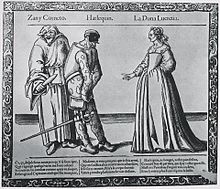
Back Влюбените Bulgarian Innamorati Spanish Innamorati Finnish Amoureux (commedia dell'arte) French אינמורטי HE Инаморати Macedonian Влюблённые (комедия дель арте) Russian مرکز محبت Urdu

Innamorati (Italian: [ʎ innamoˈraːti]; lit. 'lovers')[2] were stock characters within the theatre style known as commedia dell'arte, who appeared in 16th-century Italy. In the plays, everything revolved around the lovers in some regard.[3] These dramatic and posh characters were present within commedia plays for the sole purpose of being in love with one another, and moreover, with themselves. These characters move elegantly and smoothly, and their young faces are unmasked unlike other commedia dell'arte characters.[4][5] Despite facing many obstacles, the lovers were always united by the end.[6][5][7][page needed]
- ^ [Artist unknown]. "Zanni, Harlequin, La Dona Lucretia" from the Recueil Fossard, XII. 1584. Woodcut print. Swedish Nationalmuseum, Stockholm.
- ^ Delpiano, Roberto (2019). "Gli Innamorati (The Lovers)". ItalianCarnival.com. Retrieved 28 November 2023.
- ^ Lawner, Lynne (1998). Harlequin on the Moon. New York: Harry N. Abrams Inc. p. 61.
- ^ Rudlin, John (1994). Commedia dell'Arte: An Actor's Handbook. London: Routledge. p. 106.
- ^ a b Grantham, Barry (2000). Playing Commedia. Nick Hern Books. p. 217. ISBN 0325003467.
- ^ Eick, Justin (21 August 2009). "Theatre History Lecture Notes: Commedia dell'Arte" (PDF). Theatrical Education Group. Archived from the original (PDF) on 19 August 2011 – via LaCanadaPlayhouse.org.
- ^ Henke, Robert (2010) [2002]. Performance and Literature in the Commedia dell'Arte. Cambridge University Press. ISBN 9780521172387. OCLC 701072868.
© MMXXIII Rich X Search. We shall prevail. All rights reserved. Rich X Search